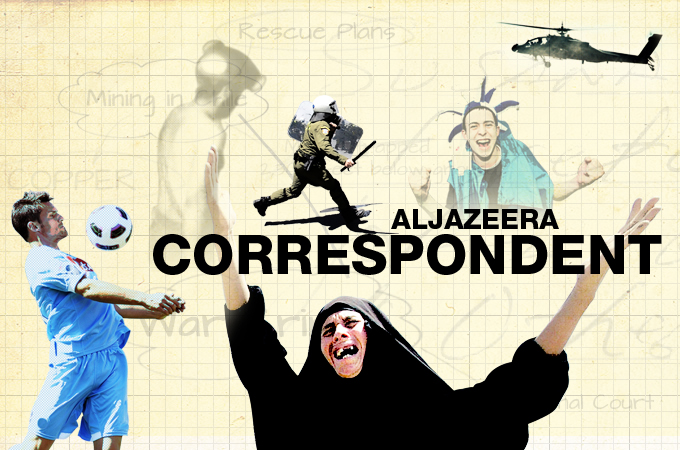
Chile’s miners: Fame without fortune
They were lauded as heroes, embraced by the media, praised by world leaders, but what happened after the cameras left?
 |
| Lucia Newman returned to Copiapo to see how the rescued miners have been coping since the media left |
By Lucia Newman
A year ago the world watched as 33 Chilean miners were stranded hundreds of metres under the ground for more than two months. Veteran correspondent Lucia Newman covered their dramatic rescue for Al Jazeera. For the film Chilean Miners: Still Trapped?, she returned to Copiapo in Chile to discover how the tragedy and the subsequent adulation that followed the rescue have impacted the lives of many miners and their families. Here she reveals some of what she found.
Fame and fortune do not necessarily go hand in hand, as Chile’s famous 33 miners have discovered all too well.
While they were still trapped 700 metres under the earth awaiting their rescue, the miners began receiving succulent offers for exclusive interviews and even book and movie deals. Once they were brought to the surface in a spectacular grand finale watched by more than a billion people worldwide, they were overwhelmed by the type of media attention most movie stars can only dream of.
They were declared heroes by world leaders and media pundits far and wide. Barack Obama, the US president, praised them as “an inspiration” and “an example of courage and determination to the world”. Sebastian Pinera, the Chilean president, handed Queen Elizabeth II a souvenir rock from the mine as if he was presenting her with an emerald.
The miners were invited to travel the world as the honoured guests of Disneyworld, the Greek Miners Union, the Israeli tourism ministry and top European football clubs, all expenses paid. Each one received a bright new Kawasaki motorcycle from the Japanese manufacturer, and a five million Chilean peso cheque (about $10,000) from Leonardo Farkas, a wealthy Chilean mine owner.
Some received a few thousand dollars for a magazine article here, a TV appearance there. But with the exception of the few miners who became the media’s favourites – for example, Mario Sepulveda, the exuberant miner dubbed “Super Mario” who came out of the capsule chanting “Chi Chi Chi Le Le Le”, and Edison Pena, who was a hit on US network television singing Elvis Presley songs – the miners have not made a lot of money as a result of their fame.
Paying the price
|
Lucia Newman returned to Copiapo to meet the miners |
On the contrary, as I found out when I went back to their hometown in Copiapo, Chile, they have paid a dear price for it.
I discovered that the majority of the miners are still struggling to cope. “We were not prepared for all this. I can’t relate to my family anymore. I feel sad and confused,” said Victor Zamora, holding back tears as he spoke to me outside his house.
“I think they should have received more psychological help after the trauma they experienced. They are still at a stage where they can’t sleep, they still have nightmares, some have anxiety attacks, depression … and even so, the insurance company gave almost all of them a clean bill of health,” says Carla Pena, a social worker who helped the miners’ families throughout their ordeal.
Seven of the miners are still receiving psychological help, though many more say they, too, are not well.
Fifty-two-year-old Yonni Barrios, the miner who made world headlines when it became known that he had ‘two wives’ fighting over him (his legal wife and his live-in partner), thanked God for his second chance at life when he was rescued. But when I visited him and his partner Susana at his modest home in a working class neighbourhood of Copiapo, he was distraught.
Like practically all of the miners, he does not have a regular job anymore and is afraid to go back into a mine, even though he says he is a miner at heart and feels empty without his old job.
He, too, could not repress his tears as he told me that neither sleeping pills nor anti-depressants were helping. “Time went by quickly while I was trapped in the mine. Now it seems to stand still. I cry at the drop of a handkerchief. I don’t talk to my old friends anymore, because they treat me differently. Nothing is the same,” he says.
While still trapped in the mine, Yonni was nicknamed “Dr House” because of his rudimentary knowledge of first aid. Now he has been diagnosed with silicosis, a debilitating and incurable lung disease common among miners.
When I met Yonni and Susana they were building a small goods store to run from their house to make ends meet. Fifty-six-year-old Jorge Galleguillos would like to buy a large truck to transport mining material, but does not have the money. Three others are selling fruit and vegetables at the local market, while Franklin Lobos, a former Chilean football star, is helping to coach young men at Copiapo’s sports club. All of them are making a fraction of what they earned at the San Jose mine.
And, one year after their fateful mining accident, even the fame is fading. Jorge says: “Here in Chile people are sick of us.”
Al Jazeera Correspondent airs each week at the following times GMT: Thursday: 2000; Friday: 1200; Saturday: 0100; Sunday: 0600; Monday: 2000; Tuesday: 1200; Wednesday: 0100; Thursday: 0600. Click here for more on Al Jazeera Correspondent. |
